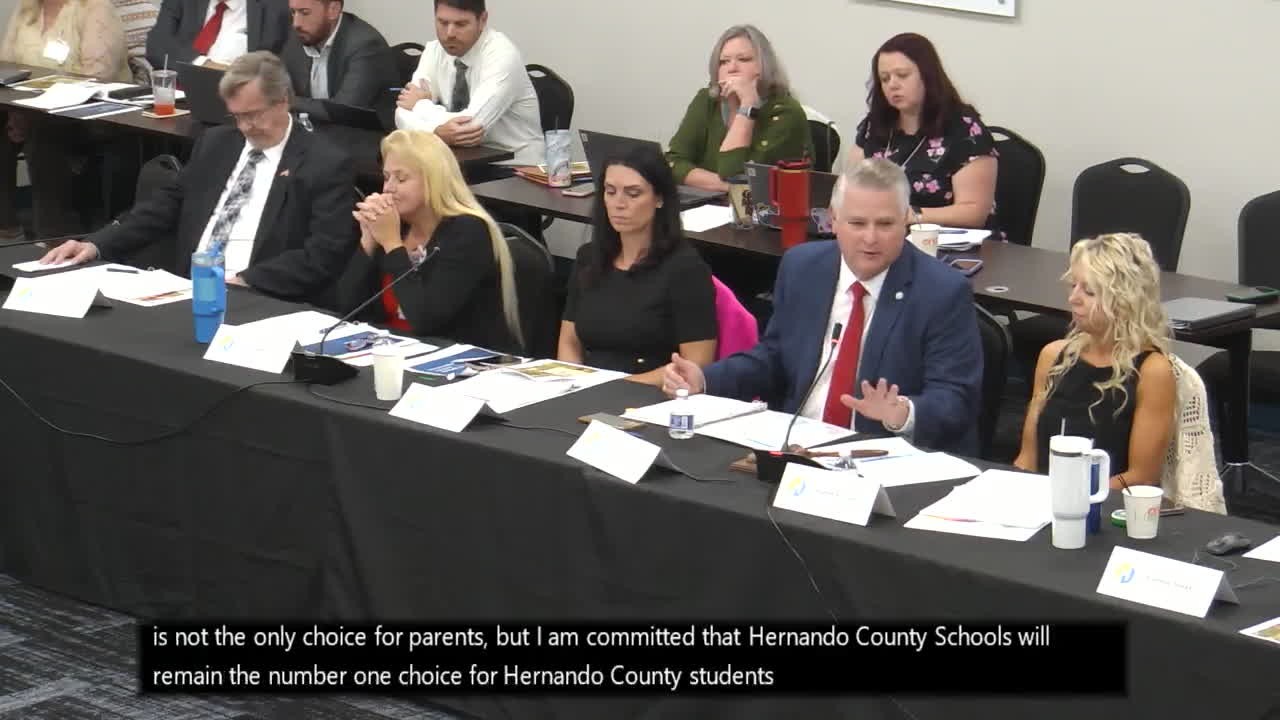Commissioners, school board weigh public access to school sports fields and a shared aquatic facility
October 17, 2025 | Hernando County, Florida
This article was created by AI summarizing key points discussed. AI makes mistakes, so for full details and context, please refer to the video of the full meeting. Please report any errors so we can fix them. Report an error »

Elected officials and school leaders on Tuesday debated whether and how to expand public access to school athletic facilities, tracks and pools while safeguarding students and limiting district liability.
Commissioner John Alaco, who placed the item on the agenda, said many county recreational needs exceed municipal park capacity and asked whether schools could open tracks and other outdoor facilities for community use during non‑school hours. School Board members and Superintendent Ray Pinder said the district already permits organized groups to use fields under a facilities‑use fee schedule that requires insurance and often a custodial or maintenance fee, but that unrestricted public access presents security and supervision challenges.
District counsel described existing joint‑use models used in other Florida counties, noting those agreements limit public access to times when school is not in session and include conditions for liability insurance and supervision. Pinder also said recent state rules on locked campus perimeters and building security have raised staffing requirements: gates and entries must be controlled when students are present, and expanded public access would create additional staffing or security costs the district currently lacks the funds to absorb.
Several speakers, including commissioners and council members, urged exploring a shared off‑campus facility such as the county’s Anderson Snow complex, or a public‑private partnership tied to a large parcel (the quarry or adjacent parkland was mentioned), where a joint aquatic center, dive well and practice facilities could serve five high schools and generate rental revenue. Supporters said a shared center could also host tournaments and generate economic activity but would require capital funding — possibly via bonding, legislative appropriations, sponsorships or partner contributions.
Why it matters: Opening school facilities or building a shared aquatic/recreation center could broaden community access, support youth athletics and reduce duplicative capital costs, but it raises safety, liability and funding challenges that need legal agreements and operating plans.
Next steps: Counsel offered to circulate sample joint‑use agreements from other counties; district and county staff agreed to explore trial agreements, case‑by‑case arrangements and potential public‑private sponsorship structures for a centralized aquatic facility.
Commissioner John Alaco, who placed the item on the agenda, said many county recreational needs exceed municipal park capacity and asked whether schools could open tracks and other outdoor facilities for community use during non‑school hours. School Board members and Superintendent Ray Pinder said the district already permits organized groups to use fields under a facilities‑use fee schedule that requires insurance and often a custodial or maintenance fee, but that unrestricted public access presents security and supervision challenges.
District counsel described existing joint‑use models used in other Florida counties, noting those agreements limit public access to times when school is not in session and include conditions for liability insurance and supervision. Pinder also said recent state rules on locked campus perimeters and building security have raised staffing requirements: gates and entries must be controlled when students are present, and expanded public access would create additional staffing or security costs the district currently lacks the funds to absorb.
Several speakers, including commissioners and council members, urged exploring a shared off‑campus facility such as the county’s Anderson Snow complex, or a public‑private partnership tied to a large parcel (the quarry or adjacent parkland was mentioned), where a joint aquatic center, dive well and practice facilities could serve five high schools and generate rental revenue. Supporters said a shared center could also host tournaments and generate economic activity but would require capital funding — possibly via bonding, legislative appropriations, sponsorships or partner contributions.
Why it matters: Opening school facilities or building a shared aquatic/recreation center could broaden community access, support youth athletics and reduce duplicative capital costs, but it raises safety, liability and funding challenges that need legal agreements and operating plans.
Next steps: Counsel offered to circulate sample joint‑use agreements from other counties; district and county staff agreed to explore trial agreements, case‑by‑case arrangements and potential public‑private sponsorship structures for a centralized aquatic facility.
Don't Miss a Word: See the Full Meeting!
Go beyond summaries. Unlock every video, transcript, and key insight with a Founder Membership.
✓
Get instant access to full meeting videos
✓
Search and clip any phrase from complete transcripts
✓
Receive AI-powered summaries & custom alerts
✓
Enjoy lifetime, unrestricted access to government data
30-day money-back guarantee
